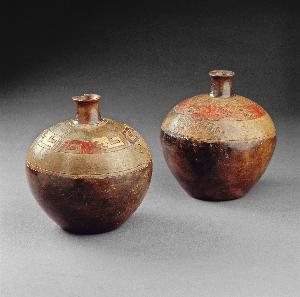Paracas Style
Paracas Style
Place: Paracas
Biography:
The Paracas Style, an ancient Peruvian culture, flourished between 700 BC and 200 AD. This style is renowned for its exquisite ceramic artistry, which has been a significant contribution to the textile arts. The Paracas Style is known for their extensive knowledge of irrigation and water management.
Artistic Contributions
The Paracas Style is characterized by its intricate designs, including incised polychrome, 'negative' resist decoration, and other wares of the Paracas tradition. The associated textiles include many complex weave structures, as well as elaborate plaiting and knotting techniques. The Paracas Necropolis textiles and embroideries are considered to be some of the finest ever produced by Pre-Columbian Andean societies.
- The Paracas Style ceramics, such as the Ceramic ceremonial vessel with incised and painted stepped designs, showcase the artist's attention to detail and mastery of their craft.
- The Paracas Style textiles, including many complex weave structures, demonstrate a high level of skill and artistry.
- The Paracas Necropolis textiles and embroideries are considered to be some of the finest ever produced by Pre-Columbian Andean societies.
Museums and Collections
The Paracas Style can be found in various museums, including the Museo Larco in Lima, Peru. The Museo Larco has an extensive collection of Paracas Style ceramics and textiles, which are considered to be some of the finest examples of Pre-Columbian Andean art. Important contributions to the understanding of the Paracas Style can be found in the https://Wikioo.org/Art.nsf/O/A@D3CFXH, which provides a comprehensive overview of the artist's work and style. Additionally, the https://Wikioo.org/@@/D4MV4X-Paracas-Style-Ceramic-ceremonial-vessel-with-incised-and-painted-stepped-de.. can be found on https://Wikioo.org, which showcases the artist's mastery of ceramic art.
Conclusion
In conclusion, the Paracas Style is a significant contributor to the world of art and textiles. The Paracas Style ceramics and textiles are considered to be some of the finest examples of Pre-Columbian Andean art, and their intricate designs and complex weave structures demonstrate a high level of skill and artistry. The Paracas Style can be found in various museums, including the Museo Larco in Lima, Peru, and their work can be seen on https://Wikioo.org.

